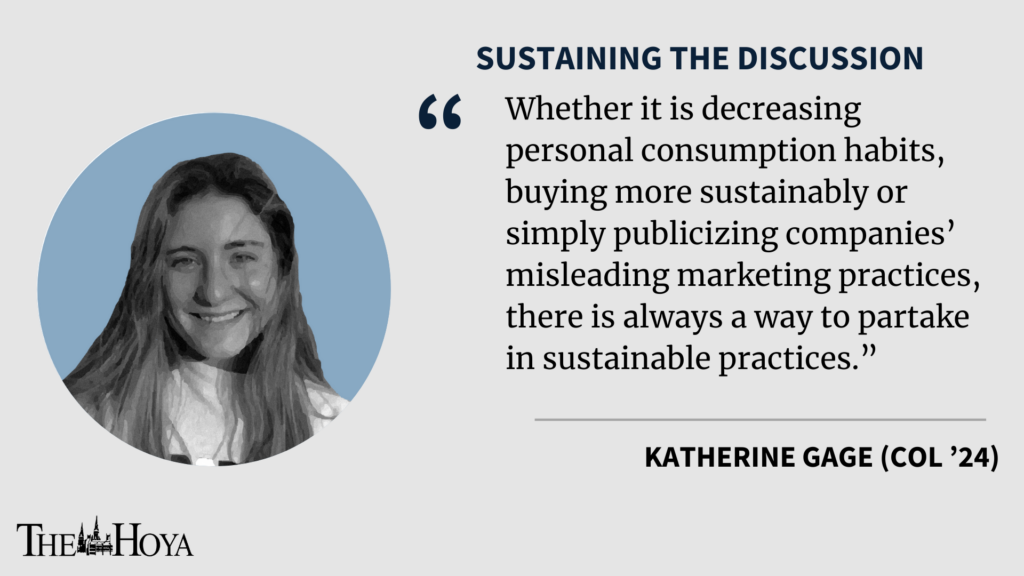Since 1970, the average amount of clothing that Americans buy has tripled. With constantly evolving fashion trends and unlimited choices for shoppers, buying hauls of clothing has become the norm. Unsurprisingly, this rapid increase in consumption has had devastating environmental impacts, such as greenhouse gas emissions and excess materials being disposed of in landfills or the ocean. Fortunately, there are many options for Georgetown University students to be more sustainable shoppers.
The movement toward sustainable fashion is gaining popularity, yet the issue with the fashion industry is its ever-evolving need to be trendy, causing consumers to continuously shop to stay on top of the newest fashion. Further, sustainable fashion is often associated with higher price tags, simpler designs and more minimal colors than some shoppers might desire. And, while some brands have been able to adopt more sustainable operations, others have struggled with the discordance between the notion of sustainable fashion and the consumer-driven fashion industry.
Consumers largely contribute to the waste created by the fashion industry by shopping from unsustainable stores. By continuing to purchase copious amounts of clothing, consumers are becoming as detrimental to the environment as the production aspect of the fashion industry. For every 2.2 pounds of fabric produced, 50.7 pounds of greenhouse gasses are emitted on average. By overbuying clothing, consumers are propelling the fashion industry toward having an even greater carbon footprint when the industry already makes up 10% of the world’s carbon emissions. Further, climate economists predict that if this level of consumption continues, the fashion industry will account for 26% of carbon emissions by 2050.
This waste is largely spurred by the notion of fast fashion, which allows consumers to buy beyond their needs and stay on top of trends without dropping their entire paycheck. But the impact of fast fashion is shown in a report from the World Resources Institute, which explains that the fashion market alone releases almost 1.2 billion tons of greenhouse gasses that contribute to global warming every year. The production of these materials strains water resources, as manufacturers use up to 713 gallons of water to create only one T-shirt. Between brands like SHEIN, ROMWE and Forever 21, it is easy to stay on top of trends. Yet, having a constant rotation of the newest clothes ends up with American consumers throwing away 81 pounds of clothing a year on average.
With unpredictable clothing trends and overproduction, 85% of textiles go into landfills every year, according to Business Insider. Since there is always a new fashion trend, new styles are constantly introduced, and brands are left with excess materials.
A way to combat this waste is by purchasing secondhand clothes to create material circulation and reduce waste. Thrifting allows clothing to be reused rather than discarded when, at the moment, 26 billion pounds of clothing end up in landfills in the United States every year. This practice can also reduce water pollution, as the fashion industry often resorts to disposing of materials in the ocean, which rarely decompose.
Additionally, many of the stores frequented by Georgetown students hide behind the term sustainable fashion without any follow-through. Companies like H&M are known for greenwashing, a marketing strategy to make clothing seem sustainable with little intention of becoming eco-friendly. Another company, ZARA, works to replicate designer clothing and markets its products as imitations of runway styles. This company is the culmination of fast fashion, as it produces clothing that resembles designer pieces, making consumers flock to its stores for the newest trends. ZARA makes little effort to be sustainable or transparent about its materials. Despite producing a long-term goal list, the company has yet to make strides to become a truly sustainable brand. These are two of many brands that claim to be sustainable only to gain favor with environmental shoppers for sales. And unsurprisingly, many companies have initiatives for sustainability that they have yet to begin.
On the other hand, if you are looking for brands in Georgetown that are committed to sustainability, Reformation and Allbirds have viable environmental initiatives. Reformation focuses on utilizing low-impact materials and reused fabrics in order to maintain a sustainable practice. Additionally, Allbirds, a shoe store, has a five-year plan detailing a sustainability guide it has begun working on. The company is also carbon neutral with plans to become carbon positive.
All in all, the transition to sustainable consumption will not be easy. Yet, you as a consumer can make an impact. As a shopper, looking for sustainable options and cutting back on overshopping will make a large impact on the environment.
Whether it is decreasing personal consumption habits, buying more sustainably or simply publicizing companies’ misleading marketing practices, there is always a way to partake in sustainable practices.
Katherine Gage is a first-year in the college. Sustaining the Discussion appears online every other Friday.










sfs23 • Aug 29, 2021 at 3:47 pm
A wonderful piece, thanks for sharing.
Looking forward to seeing more from you!
wuxiaworld • Aug 6, 2021 at 4:05 am
I like the way you cook the food. very tasty and attractive.
cookie clicker
Breanna Smith • Jul 12, 2021 at 8:43 am
Wow! such fabulous full fashion tips this so an important and informational blog thanks for sharing…
binicar menorca • Jun 18, 2021 at 3:57 am
thanks for share really thanks